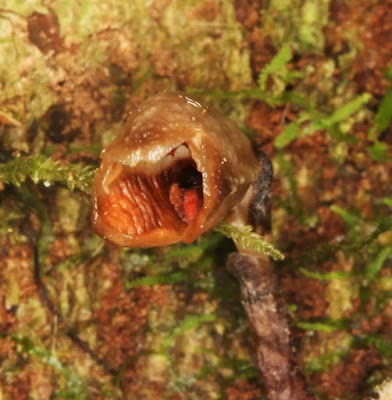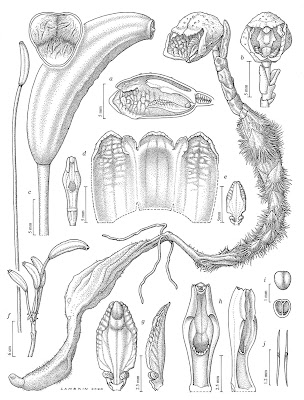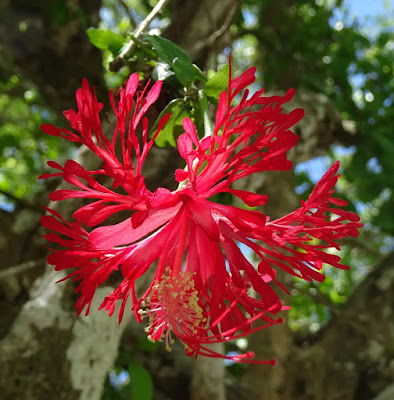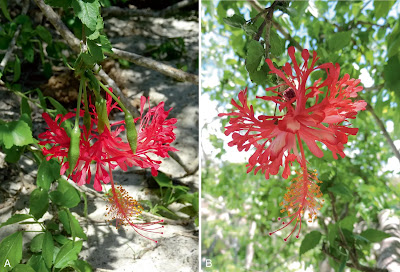[Most Recent Entries] [Calendar View]
Thursday, December 17th, 2020
| Time | Event | ||||
| 9:55a | [Botany • 2021] Billolivia lamdongensis (Gesneriaceae) • A New Species from Central Highlands, Vietnam
Billolivia lamdongensis Hareesh, T.A. Le & D.D. Nguyen sp. nova (Gesneriaceae) is described and illustrated from Central Highlands, Vietnam. It resembles B. vietnamensis but differs from the latter in having short hairs on the adaxial surface of the lamina; ovate-lanceolate bracts; linear calyx lobes 3/4 length of the corolla tube; a white corolla with a yellow throat and a dark purple patch between the upper lips on both surfaces; and fruits with pubescence all over. 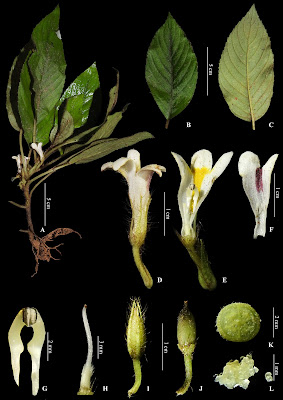 Hareesh V.S., Nguyen D.D. and Le T.A. 2021. Billolivia lamdongensis (Gesneriaceae), A New Species from Vietnam. Ann. Bot. Fennici. 58: 73–77. sekj.org/anbf_new.html | ||||
| 10:11a | [Botany • 2020] Gastrodia agnicellus (Orchidaceae) • A New Holomycotrophic Orchid from southeast Madagascar
Summary The new orchid, Gastrodia agnicellus from Madagascar is described for the first time and compared with similar species from the region. Its unusual holomycotrophic habit and flowering beneath leaf humus are discussed; a full description and detailed illustration are provided.
Gastrodia agnicellus Hermans & P.J.Cribb, sp. nov. Type: Madagascar, Fianarantsoa Prov., near Ifanadiana, c. 800 m, ex Malala, 1999, Hermans 2355 (holotype, K). Fianarantsoa Prov., Ranomafana, Sept. 2019, Field Observations, Hermans et al. (photographs K). Distribution: Endemic to SE Madagascar. Habitat: Humid evergreen forest, in deep shade underneath leaf litter and humus; 600–850 m. Etymology: The species name refers to the woolly covering on the rhizome, the ear‐like petals and also alludes to the name of the botanical artist who brought the new species to life in her drawing. Conservation: The new species has only been recorded from the Vatovavy‐Fitovinany region, Fianarantsoa province. One of the sites is within the Ranomafana Protected Area, the extent of occurrence is estimated to be very small and in continuing decline due to habitat destruction caused by fire and agriculture. In addition, Gastrodia require specific mycorrhizal associations for carbon uptake throughout their life cycle (Martos et al., 2009, 2015a, 2015b). These combined factors are likely to mean that the new species is Endangered. Johan Hermans. 2020. GASTRODIA AGNICELLUS: A New Holomycotrophic Orchid (Orchidaceae) from southeast Madagascar. Curtis's Botanical Magazine. DOI: 10.1111/curt.12354 | ||||
| 1:00p | [Botany • 2020] Hibiscus hareyae (sect. Lilibiscus; Malvaceae) • Threatened in Coastal Thicket at Lindi, Tanzania Summary The spectacular new species with horticultural potential described in this paper, Hibiscus hareyae L.A.J.Thomson & Cheek, was identified during an assessment of online digitised botanical specimens of H. schizopetalus (Dyer) Hook.f. as part of a review of species in Hibiscus sect. Lilibiscus Hochr. A short updated description and delimitation of the horticulturally important sect. Lilibiscus is presented. Flowering and fruiting specimens of Hibiscus hareyae are readily distinguished from H. schizopetalus by their short (0.4 – 2 (– 4.5) cm long, non-articulated peduncle-pedicels vs (6 –) 8 – 11 (– 14) cm long, articulated peduncle-pedicels, and larger, broader epicalyx bracts (1.5 – 4 × 1 – 1.2 mm vs 0.6 – 1.5 × 0.1 – 0.3 (– 0.5) mm), the epicalyx forming a shallow cup 0.5 – 1 × 2 – 3 mm vs bracts appearing free. The absence of an articulation of the peduncle-pedicel of H. hareyae is unique within sect. Lilibiscus. The species is also well-marked from H. schizopetalus by other morphological differences in corolla and foliage, and in ecology and geography. Hibiscus hareyae has a restricted natural distribution as an element in deciduous coastal thicket, usually on coral rag formations, sometimes in or near mangrove, in Lindi Province, southern Tanzania. It ranges from the Indian Ocean coast to as much as 20 km inland, from about 8.5oS to 10oS (c. 140 × 20 km) and is assessed as Vulnerable (VU B2ab(iii)). Hibiscus hareyae has high ornamental potential but is unknown in cultivation. Key Words: Africa, conservation, coral rag, Hibiscus schizopetalus, horticulture Hibiscus hareyae L.A.J.Thomson & Cheek sp. nov. Type: Tanzania, Lindi Province, “Collected July 1877. Lindi, E. Africa, Lat. 9 40’ South this extends its habitats a little further South than before”, Kirk s.n. (holotype K00240493!) (Fig. 1). RECOGNITION. Within Hibiscus, H. hareyae and H. schizopetalus are the only two species with laciniate petals. Hibiscus hareyae is readily distinguished from H. schizopetalus by its much shorter and non-articulated peduncle-pedicels (0.4 – 2 cm long vs 8 – 14 cm long and articulated); longer and broader epicalyx bracts, (1.5 – 4 × 1 – 1.2 mm vs 0.6 – 1.5 × 0.1 – 0.3 (0.5) mm, the epicalyx forming a shallow cup 0.5 – 1 × 2 – 3 mm, vs bracts appearing free (for additional diagnostic characters see Table 1). ETYMOLOGY. The specific epithet honours Dr Hareya Fassil (12 Jan. 1968 – present) in recognition of her work on conservation of plant genetic resources and the roles of traditional plant-based medicines in Africa. VERNACULAR NAMES. Mgongonyoka (Swahili) and Kinyoka (Yau) (both Litchfield 5457); Lindi hibiscus (English). Lex A. J. Thomson and Martin Cheek. 2020. Discovered Online: Hibiscus hareyae sp. nov. of sect. Lilibiscus (Malvaceae), Threatened in Coastal Thicket at Lindi, Tanzania. Kew Bulletin. 75: 51. DOI: 10.1007/s12225-020-09911-6 |
| << Previous Day |
2020/12/17 [Calendar] |
Next Day >> |



